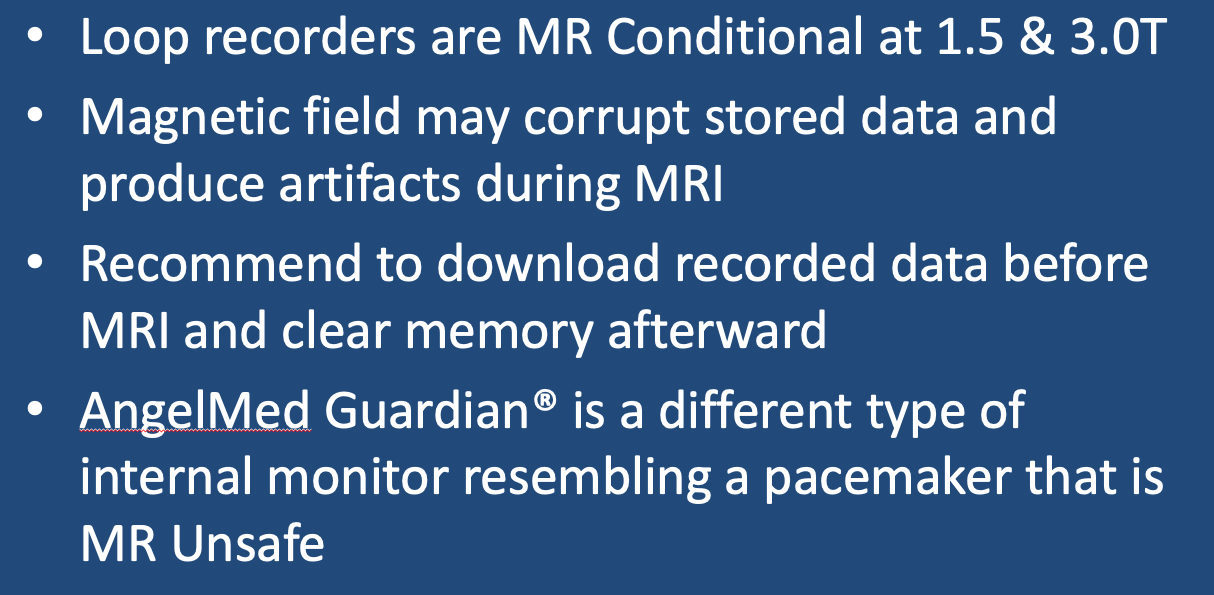|
Implantable loop recorders are diagnostic devices produced by several companies placed subcutaneously in the chest to record the EKG in patients with suspected intermittent arrhythmias. No external leads are present. Information from the device is retrieved by a wireless interrogation procedure.
Loop recorders are considered MR Conditional at 1.5T and/or 3.0T. Local transmit coils are prohibited, but receive coils may be used. Because data may be corrupted or erased by magnetic fields, it is recommended that any desired recorded information be downloaded before the MRI and cleared after the MRI.
|
A unique type of internal cardiac monitor is the AngelMed Guardian® (Angel Medical Systems). This device closely resembles a pacemaker, with a battery-powered, titanium-encased cardiac monitor (the size and shape of a pulse generator) subcutaneously implanted in the upper chest and a wire electrode passed intravenously into the right ventricle. The Guardian® records electrical activity (such as arrhythmias and ST-segment changes that could be indicative of an acute coronary event) and sends vibrating alarms to the patient. A wireless signal is also transmitted to a separate external programmer device that beeps and flashes. The Guardian® is thus a purely diagnostic device and does not have pacing or shocking capabilities. It is considered MR Unsafe by its manufacturer.
Advanced Discussion (show/hide)»
No supplementary material yet. Check back soon!
References
Blaschke F, Lacour P, Walter T, et al. Cardiovascular magnetic resonance imaging in patients with an implantable loop recorder. Ann Noninvasive Electrocardiol 2016; 21:319-324.
Gimbel JR, Zarghami J, Machado C, et al. Safe scanning, but frequent artifacts mimicking bradycardia and tachycardia during magnetic resonance imaging (MRI) in patients with an implantable loop recorder (ILR). Ann Noninvasive Electrocardiol 2005; 28:1041-1046. [DOI LINK]
Indik JH, Gimbel JR, Abe H, et al. 2017 HRS expert consensus statement on magnetic resonance imaging and radiation exposure in patients with cardiovascular implantable electronic devices. Health Rhythm 2017; 14:e97-e153. [DOI Link]
Kazmi SHA, Datta S, Chi G, et al. The AngelMed Guardian® System in the detection of coronary artery occlusion; current perspectives. Medical Devices: Evidence and Research 2020; 13:1-12.
Blaschke F, Lacour P, Walter T, et al. Cardiovascular magnetic resonance imaging in patients with an implantable loop recorder. Ann Noninvasive Electrocardiol 2016; 21:319-324.
Gimbel JR, Zarghami J, Machado C, et al. Safe scanning, but frequent artifacts mimicking bradycardia and tachycardia during magnetic resonance imaging (MRI) in patients with an implantable loop recorder (ILR). Ann Noninvasive Electrocardiol 2005; 28:1041-1046. [DOI LINK]
Indik JH, Gimbel JR, Abe H, et al. 2017 HRS expert consensus statement on magnetic resonance imaging and radiation exposure in patients with cardiovascular implantable electronic devices. Health Rhythm 2017; 14:e97-e153. [DOI Link]
Kazmi SHA, Datta S, Chi G, et al. The AngelMed Guardian® System in the detection of coronary artery occlusion; current perspectives. Medical Devices: Evidence and Research 2020; 13:1-12.
Related Questions
What does it mean when an implant or device is labeled "conditional"?
What does it mean when an implant or device is labeled "conditional"?

